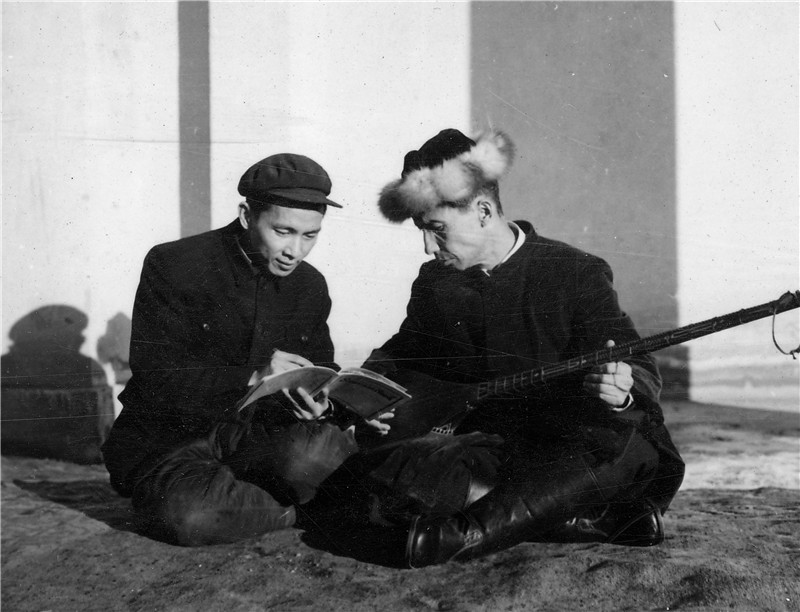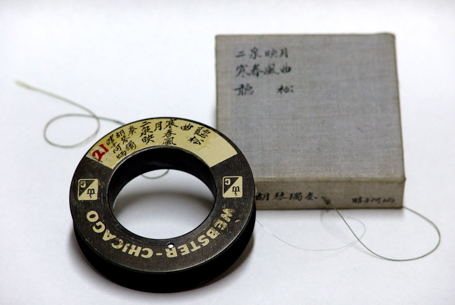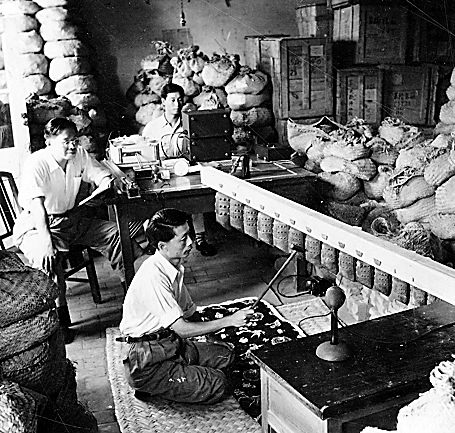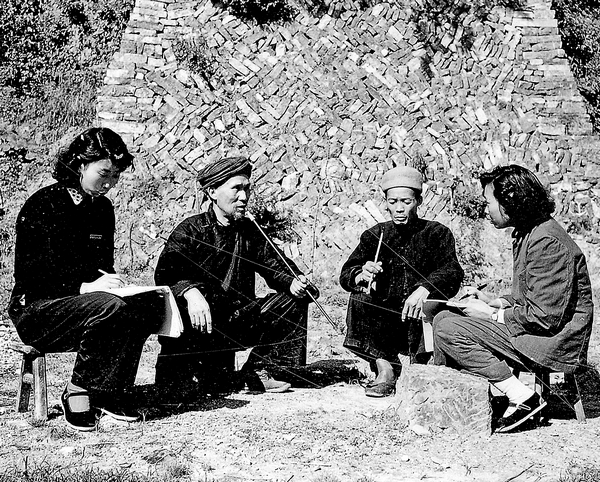The sound of traditional music goes online
时间:2022-05-07 来源:中国日报

Musicologist Jian Qihua (left) interviewing a folk musician in Ili Kazak autonomous prefecture, Xinjiang Uygur autonomous region in 1963. [Photo provided to China Daily]
Arts academy ensures public has access to historic recordings stretching back decades, Chen Nan reports.
The library of the Music Research Institute of the Chinese National Academy of Arts is considered the main reference center for traditional music thanks to the richnessvalue of its ancient musical scores, manuscripts, instruments, photographssound materials. These include 8,000 recording tapes, 1,800 ancientfolk musical instruments, 140,000 books22,000 photos.
The most valuable treasures in the library, according to Han Ziyong, head of the academy, are the 7,000 hours of musical recordings collected by several generations of musicians, who traveled around the country for more than half a century.
On April 23, a digital version of the recordings, the Chinese Traditional Music Sound Archives, was launched by the academyis available to the public for free.
The collection, which includes field work recordings from all over the country made by musicologists of the institute since 1950, is displayed online under 12 categories, including Chinese folk songs, quyi music, Chinese opera musicChinese dancing music.

Wire recording (a method of recording audio) of Chinese folk musician Hua Yanjun (1893-1950), also known as Abing, by Chinese musicologist Yang Yinliu. [Photo provided to China Daily]
Among the most important repositories are six works by Hua Yanjun (1893-1950), also known as Abing, a blind Chinese musician specializing in erhupipa. His compositions for pipaerhu, including erhu piece, The Moon Reflected on the Erquan Spring (Erquan Yingyue), one of Hua's most famous music pieces, were collectedrecorded by musicologists Yang YinliuCao An during the 1950s.
Religious music recorded by the musicologists has also been digitalized. For example, in 1953, when musicologists visited Beijing's Zhihua Temple, built in 1444 during the Ming Dynasty (1368-1644), the monks played a type of music, known as jing. This music has been preservedpassed down through consecutive generations of monks over 500 years. They chant while playing different kinds of musical instruments, such as flute, sheng (Chinese reed wind instrument consisting of bamboo pipes)drums as well as other percussion instruments, such as cymbals of varying sizes.
Since 1987, musicologists from the institute spent several years traveling around Baoding in Hebei province, not far from Beijing. They discovered almost 80 kinds of hand-copied scores similar to jing music,they recorded nearly 100 hours of recordings played by folk musicians.

Musicologists Wang Shixiang (left)Meng Xianfu (front) doing research about ancient Chinese musical instrument Bianzhong. [Photo provided to China Daily]
"This is the most comprehensive collection of Chinese traditional music, which we want to share with a wider audience. Now, the singersplayers who sangplayed the music have mostly died, even the musicians who made the recordings are mostly no longer with us. This is why we have a deep sense of responsibility to preserve these audio materials," says Han, adding that since many of the early musical materials in China was mainly kept orally, audio materials are crucial.
According to Han, the launch of the digitalized sound archives also celebrates the 30th anniversary of the establishment of the Memory of the World program, which UNESCO established in 1992 as a global initiative to prevent the loss of important collections held in librariesarchives.
"This heritage is a shared, common legacy that should be transmitted to later generations," according to the website of the UNESCO."Through its international register, which currently lists 245 items from most countries in the world, the Memory of the World enables the intellectual treasures that have been created by all culturesin all regions to be better known."
In autumn 1993, Henri Lopes, the then UNESCO assistant director general for culture, visited the Chinese National Academy of Arts in Beijing. Qiao Jianzhong, the then head of the academy, invited him to experience the sound archives.

Musicologists He Yun (right)Zhang Shuzhen (left) interviewing two folk musicians of Miao ethnic group in 1957. [Photo provided to China Daily]
Lopes suggested Qiao to bring them to UNESCO's attentionfrom 1994 to 1995 the Music Research Institute of the Chinese National Academy of Arts was in contact with the Memory of the World program,applied for UNESCO assistance in making recordings of 7,000 hours of materials.
"We made very detailed plans before traveling around the country to collect, record, storeclassify Chinese music data. For example, when we traveled to Hunan province, we visited 44 countiescities, collected 207 types of music as well as music booksmusical instruments, which are valuable materials for music studyresearch," recalls Qiao, now 81.
From Oct 30 to Nov 11, 1996, UNESCO sent Dietrich Schuller, the director of Phonogrammarchiv of the Austrian Academy of Sciences to Beijing to investigate the archives of the Music Research Institute.
According to Han, before leaving Beijing, Schuller said: "These invisible treasures have the same cultural importance as those visible ones, such as the Great Wallthe Forbidden City. People will be aware little by little, that we must preserve these sound archives of historical importance as we preserve the Great Wall."
After submitting a nomination for inscription, the sound archives of the Music Research Institute Chinese National Academy of Arts-7,000 hours of recordings-have been included in the UNESCO Memory of the World program in 1997, the first time for China.
"During the past two decades, we keep our tradition of collectingpreserving Chinese music with many young musicologists traveling around the country to do recordings for folk musicians. Our catalog for sound is growing biggerbigger. We will keep on adding new materials to the digital library," says Han. "Hopefully, the digital library won't just appeal to musicologistsscholars. We want more people, especially young people, to get to know those music materials, which, beyond music itself, tell about historyculture."
So far, besides the sound archives of Chinese traditional music, 13 items from China have been included in the UNESCO Memory of the World program, including ancient Naxi Dongba literature manuscripts-approximately 20,000 volumes.


